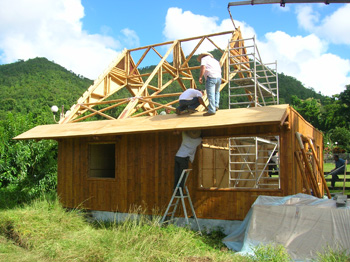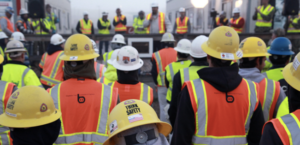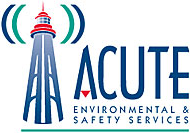Ontario workplaces spent $52M on work-related compensation and other losses in 2015 relating to falls alone. Go with the best worksite safety and working at heights training to prevent your team from being included in these injury statistics. Contact Ontario’s trusted working at heights trainer today. ACUTE offers the best choice for organization targeting a zero incident rate, through quality training by professionals who have done the field work first hand. Safety, it’s all that we do!
“I’ve been using ACUTE for a number of years now. What started with lift truck and crane training has expanded to have them providing most of my H&S disciplines. The customer service is the best I have encountered; they work with me and accommodate my schedules for multiple locations; our employees really like the trainers and content is the best and most relevant to my needs as I have ever found. I recommend ACUTE to everyone looking for competent, professional training services.”
-Rob
For more reviews please feel free to see here.
 Why Managing Towards Zero Incidents in Worksite Safety is Important
Why Managing Towards Zero Incidents in Worksite Safety is Important
Safety incidents involve events that expose workers to risks in health and well-being that sometimes lead to injury or fatalities. A safety incident includes employees slipping at the worksite even if they did not incur any immediate injuries. Zero Incidents (Zero Accidents Vision) focuses not only on limiting the number of injuries or fatalities but simply the hazards that can cause these unfortunate events. Managing towards zero incidents should be the focus of all health and safety committees and representatives. Recognizing that all forms of work require a certain amount of risk is important, so that careful planning and execution can be done. Here is why managing towards zero incidents for worksite safety is important in the construction industry as an example:
- 40,000 injuries from falls occur every year in Canada (OHS Canada)
- 28% of fatalities and diseases resulted from construction site work between 2005-2014 (Ministry of Labour, Immigration, Training and Skills Development)
- 8,000 deaths in Ontario from working at heights in 2014 (WSIB)
- Culture breeds safety excellence or negligence: managing towards zero incidents improves safety culture
The Ministry’s annual report for 2014-2015 notes that the construction industry has the highest percentage of traumatic and occupational disease fatalities of any industry. This means worksites are statistically more prone to workplace injuries. Managing towards zero incidents is a must have for construction sites to promote safe work practices and a culture of joint responsibility and teamwork for minimizing injuries.
 5 Success Stories and Ideas from Managing Towards Zero Incidents
5 Success Stories and Ideas from Managing Towards Zero Incidents
TNO published their findings from a report on implementation success factors using the zero Zero Accidents Vision method. Here are 5 things we learned from the report from construction companies who successfully implemented a managing towards zero incidents program.
- Do creative and perform periodic audits – One company integrated this philosophy throughout its processes, from on-boarding to periodic audits. Get employees to demonstrate what they would do if exposed to certain hazards.
- Utilize branding and technology – One company developed a zero accident program with its own logo and app for reporting near misses. These helped the team achieve its first-ever one month without any accidents!
- Strong leadership support and openness to challenges – A manufacturing sector company lowered its injuries and fatalities, which were already low for the industry, by another 85%. They encouraged employees to challenge them to push towards zero incidents. This was enabled by the strong visibility of management in their commitment to zero incidents.
- Hire safety-minded professionals – One company actively sought after candidates that could demonstrate proactive safety mindsets for themselves and team members. The company continues to hold low accident rates.
- Focus on rapid, continuous improvement – One company, along with leadership and full organizational support for zero accidents, leveraged a rapid response to promote learning from incidents by implementing feedback.
These success stories highlight how companies can make significant gains in Zero Incident workplaces. See the full report here for more ideas in successfully implementing this program.
Worksite Safety: Key Principles to Managing Towards Zero Incidents
Here are some great principles to establish and draw your team into consensus:
- Reduce the hazards – Ensure that employees are working at the absolute minimum exposure profile to safety hazards.
- Identify and manage each hazard – This may be an on-going process, but establish procedures and recommended tools for managing each hazard. Go one step further and have someone on the team be responsible for managing specific hazards.
- Lead by example – Have respected worksite staff or supervisors practice safe working methods.
- Celebrate and reflect – Celebrate when safety behaviours are practiced and debrief when there are incidents.
- Make it everyone’s priority – Incentivize your team with rewards like free coffee or lunch if the team goes through a month without an incident.
- Provide hands-on training – The time-tested method for managing towards zero incidents through improved safety outcomes.
ACUTE’s Working at Heights (WAH) CPO Approved Training
ACUTE can provide training on-site at our best-in-class facility, or ACUTE trainers can come to your workplace for a variety of flexible options that continue to help clients meet their most pressing health and safety challenges. Take all of the ACUTE’s Working at Heights courses in 2 days or 15 hours of training.
 Working at Heights Ontario Training (Required by MLITSD)
Working at Heights Ontario Training (Required by MLITSD)
ACUTE’s Working at Heights training program has been approved by the Chief Prevention Officer under the Ministry of Labour, Immigration, Training and Skills Development’s Working at Heights Training Program Standard and the Working at Heights Training Provider Standard. The ACUTE Working at Heights training provides both theoretical and hands-on practical training and evaluation facilitated by highly skilled and competent instructors.
Objective: The purpose of a working at heights training program is to:
- Strengthen workplace safety culture – By elevating the profile and importance of preventing falls from heights.
- Knowledge and safety practices – Provide workers who may be exposed to falling hazards with adequate knowledge and general safety practices to work safely at heights.
- Purpose and use of equipment – Provide workers who use personal fall protection equipment with sufficient knowledge about its purpose and use.
- Incident reduction – Reduce the number of fall-from-heights incidents, injuries, and fatalities.
See here for full course details.
ACUTE Site Safety Training Differentiators
Get the best training for your team working on site at construction projects. Become a success story, not a statistic with the help of ACUTE’s qualified and passionate trainers. Choose to pay for prevention rather than paying for consequences. ACUTE offers the best hands-on training with its world-class training facility offering real-life working at heights hazard simulators.
- Open Door Instructor-Student Partnersh
 ip – ACUTE’s training services emphasize client participation. Staff want to build a relationship with each client and serve as a touchstone for advice anytime moving forward.
ip – ACUTE’s training services emphasize client participation. Staff want to build a relationship with each client and serve as a touchstone for advice anytime moving forward. - Serving Your Team and Industry – With a vast array of clients in manufacturing, construction, health, academic, and government sectors, ACUTE brings the best safety practices from across the spectrum to your workplace.
- 100 Years Combined Experience – ACUTE provides comprehensive health and safety training, on-site safety services and consulting services. With over 100 years of combined experience, our company staff offer more than theoretical or abstract ideas. ACUTE offers solutions.
- Track Record of Success – ACUTE is rated 4.9/5 stars on Google reviews, demonstrating a commitment to our clients, quality, and passion for training.
Contact us today for quality training in your workplace or on-site at ACUTE’s proven training facilities!
ACUTE is located in Waterloo, Ontario and services customers from the cities such as Toronto, Mississauga, Brampton, Hamilton, Milton, Kitchener, London, Guelph,and other cities from across Ontario.
Sources:
https://www.labour.gov.on.ca/english/hs/pdf/annualreport2014.pdf


